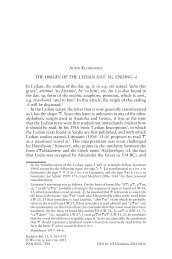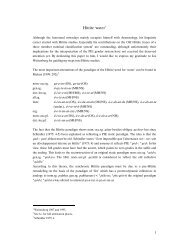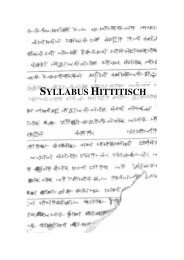The signs TA and DA in Old Hittite: evidence for a ... - Alwin Kloekhorst
The signs TA and DA in Old Hittite: evidence for a ... - Alwin Kloekhorst
The signs TA and DA in Old Hittite: evidence for a ... - Alwin Kloekhorst
- No tags were found...
Create successful ePaper yourself
Turn your PDF publications into a flip-book with our unique Google optimized e-Paper software.
138Alw<strong>in</strong> <strong>Kloekhorst</strong>,<strong>The</strong> Signs <strong>TA</strong> <strong>and</strong> <strong>DA</strong> <strong>in</strong> <strong>Old</strong> <strong>Hittite</strong><strong>The</strong> question now is: why would PIE *-nd- yield Hitt. [-nt-], whereas PIE *-nt- <strong>and</strong>*-nd h - yielded Hitt. [-nd-]? <strong>The</strong> solution to this question lies <strong>in</strong> one’s <strong>in</strong>terpretation of thephonetic properties of PIE *d. As I have already stated above, <strong>in</strong> word-<strong>in</strong>ternal positionthe <strong>Hittite</strong> lenis stops, which are the outcomes of the PIE voiced (*b,*d, etc.) <strong>and</strong> voicedaspirated (*b h ,*d h , etc.) stops, are synchronically voiceless short stops ([p], [t], etc.). Moreover,<strong>in</strong> <strong>Kloekhorst</strong> (2012: 258–259), 51 I have po<strong>in</strong>ted out that the outcomes of the PIEvoiced stops, but not PIE voiced aspirated stops, have <strong>in</strong> <strong>Hittite</strong> <strong>and</strong> Luwian certa<strong>in</strong> effectson preced<strong>in</strong>g vowels that <strong>in</strong>dicate that at the Proto-Anatolian level these consonants musthave been pre-glottalized. This means that we can assume that the Proto-Anatolianoutcome of the PIE voiced stops must have been pre-glottalized voiceless short stops:*[ / p], *[ / t], etc. In the case of the PIE cluster *-nd-, we there<strong>for</strong>e have to assume a PAnat.prestage *[-n / t-].<strong>The</strong> effect that the glottalic element of the pre-glottalized consontants *[ / p], *[ / t], etc.,had on a preced<strong>in</strong>g vowel is comparable to the effect that *h 1 had on a preced<strong>in</strong>g vowel:both cause lengthen<strong>in</strong>g of that vowel.We may there<strong>for</strong>e hypothesize that also <strong>in</strong> the cluster*[-n / t-] the glottalic element has an effect on its neighbour<strong>in</strong>g sounds that is comparable tothe effects of *h 1 <strong>in</strong> similar clusters. It is there<strong>for</strong>e <strong>in</strong>terest<strong>in</strong>g to see that <strong>in</strong> clusters consist<strong>in</strong>gof a nasal, a *h 1 <strong>and</strong> a sibilant, the laryngeal prevented assimilation of its neighbour<strong>in</strong>gsounds. For <strong>in</strong>stance, although the PIE cluster *-ns- yielded Hitt. -šš- (e.g. *dénsu-> daššu- ‘strong, powerful’), with full assimilation of the nasal to the sibilant, the PIEcluster *-nh 1 s- yielded Hitt. -nz- (e.g. *ǵénh 1 su- > genzu- ‘lap, abdomen’), with preservationof the nasal. Apparently, the *h 1 blocked the assimilation. Similarly, although PIE *-msyieldedHitt. -šš- (e.g. *h 2 émsu- > ˘haššu- ‘k<strong>in</strong>g’), with full assimilation of the nasal to thesibilant, the cluster *-mh 1 s- yielded Hitt. -nš- (e.g. *h 2 ómh 1 sei > ānši ‘he wipes’), with preservationof the nasal. We there<strong>for</strong>e may assume that, just as *h 1 <strong>in</strong> the clusters *-nh 1 s- <strong>and</strong>*-mh 1 s- prevented assimilation of the nasal to the sibilant, the glottalic element of *[ / t] <strong>in</strong>the cluster *[-n / t-] prevented voice assimilation of the dental to the preced<strong>in</strong>g nasal, so thatthe voiceless stop could rema<strong>in</strong> voiceless. To my m<strong>in</strong>d, this is the most straight<strong>for</strong>ward wayto expla<strong>in</strong> Hitt. [-nt-] from PIE *-nd-.Group 3In the words of Group 3, the cluster -nT- is consistently spelled with d-<strong>signs</strong> (never witht-<strong>signs</strong>). As we have seen, it is not fully clear what the etymology of this cluster is. <strong>The</strong> onlytwo words of IE orig<strong>in</strong> that conta<strong>in</strong> it, <strong>and</strong>a ‘<strong>in</strong>to’ <strong>and</strong> <strong>and</strong>an ‘<strong>in</strong>side’, are usually reconstructed<strong>and</strong> as *h 1 (e)ndo as *h 1 (e)ndom, respectively, with a cluster *-nd-. However, thesereconstructions with *-nd- conflict with the fact that <strong>in</strong> the words of Group 2 the cluster*-nd- yielded <strong>Old</strong> <strong>Hittite</strong> [-nt-], with consistent spell<strong>in</strong>g with t-<strong>signs</strong>. I there<strong>for</strong>e assume thatthis reconstruction of <strong>and</strong>a <strong>and</strong> <strong>and</strong>an cannot be correct. Moreover, s<strong>in</strong>ce PIE *-nt- <strong>and</strong>*-nd h - yielded <strong>Old</strong> <strong>Hittite</strong> [-nd-], which is spelled both with t-<strong>signs</strong> <strong>and</strong> with d-<strong>signs</strong>, thecluster -nd- <strong>in</strong> <strong>and</strong>a <strong>and</strong> <strong>and</strong>an, which is consistently spelled with d-<strong>signs</strong>, cannot reflect51Cf. also <strong>Kloekhorst</strong> (<strong>for</strong>thcom<strong>in</strong>g, § 2.5.3 <strong>and</strong> § 3.5.2).






